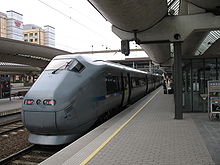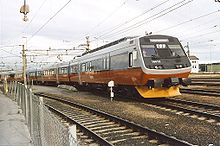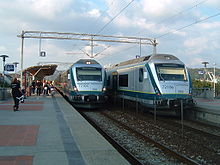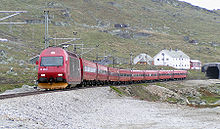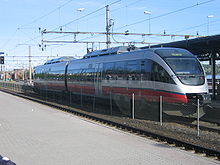- Norwegian State Railways
-
For the former government agency, see Norwegian State Railways (1883–1996).
Norges Statsbaner AS Type State-owned Industry Transport Founded 1996 Headquarters Oslo, Norway Area served Norway Key people Einar Enger (CEO, leaves 2011)
Ingeborg Moen Borgerud (chair)Revenue NOK 11 billion (2009) Operating income  NOK 548 million (2009)
NOK 548 million (2009)Net income  NOK 497 million (2009)
NOK 497 million (2009)Employees 10,646 (2006) Parent Norwegian Ministry of Transport and Communications Subsidiaries Nettbuss
NSB Gjøvikbanen
Tågkompaniet
Mantena
CargoNet (55%)Website www.nsb.no Norges Statsbaner AS, also known as the Norwegian State Railways and NSB, is a company which is responsible for most passenger train operation in Norway. Owned by the Norwegian Ministry of Transport and Communications, it is also engaged in real estate through Rom Eiendom, bus transport through Nettbuss, cargo trains through CargoNet and foreign train transport through Tågkompaniet. In 2009, NSB transported 52 million train passengers and 104 million bus passengers.
The Norwegian passenger train division has a fleet of 36 Class 72 and 82 Class 69 electric multiple units (EMU) and 14 Class 92 diesel multiple units (DMU) for commuter services. The company has a further 22 Class 73 and 16 Class 70 EMUs and Class 93 DMUs for regional and intercity trains, which are also provided by 22 El 18 and 5 Di 4 locomotives which haul Class 5 and Class 7 passenger cars. NSB receives subsidies to operate unprofitable route from its owner, while services on the Gjøvik Line have been made subject to public service obligations, which is operated by NSB's subsidiary NSB Gjøvikbanen.
The current company was established on 1 December 1996, when the former government agency with the same name was split into the new NSB, the infrastructure company the Norwegian National Rail Administration and the Norwegian Railway Inspectorate.
Contents
History
Main article: Chronology of Norwegian railway linesPrehistory: 1854–1883
The first Norwegian locomotive railway, Hovedbanen between Oslo and Eidsvoll, was opened on 1 September 1854. This 68 km long standard gauge railway terminated at the end of the lake Mjøsa and steam ship services were provided up the lake to Lillehammer. This first railway was constructed by British engineers, and the financing was divided between British investors and the Government of Norway. The total construction cost of this railway was 2 million Spesidaler, though the investment was highly profitable because of the large amount of lumber transported on the rail. This railway represented an enormous boost to the vital Norwegian lumber industry. Also along this and all later railways were constructed telegraph lines.[1] Hovedbanen was formally a private railway until 1926, but the Norwegian Government had great influence on the railway from the very beginning.
The next railway to be constructed was also the first state railways, decided in the Parliament of Norway in 1857. On 23 June 1862 the narrow gauge Hamar-Grundsetbanen was opened. It was followed by the standard gauge Kongsvingerbanen that opened on 3 October between Lillestrøm and Kongsvinger, thus making a connection to Sweden (that Norway at that point was in union with) possible. The third of the first three lines was the narrow gauge Trondhjem-Størenbanen, opened in 1864. In the following years many other railways where constructed, including the Randsfjord Line in 1868, the Drammen Line in 1872, the Røros Line in 1877, the Jær Line in 1878, the Østfold Line in 1879 and the Eastern Østfold Line (1882), the Hedmark Line in 1880 and both the Vestfold Line and the Meråker Line in 1882. These railways were completely controlled by the state even if others had stocks and got revenue.
Foundation
Norwegian State Railways was formally founded in 1883 by establishing a central head office (Hovedstyrelsen) in Kristiania for all state railways built from 1857 and later. The state railways was grouped into six districts, each governed by a district headmaster (Distrikts Chef) and his office. These were situated in Kristiania, Drammen, Hamar, Trondhjem, Stavanger and Bergen. Offices in Kristiansand, Narvik and Arendal was established later. These administrative structure was mostly unchanged until 1989.
Great expansion
In 1890 the Norwegian Parliament decided to restart railway projects in Norway, after seven years of complete stop. A lot of lines were constructed in the years to come, and the nation got some kind of a railway network, with Oslo as a centre. The main lines were completed gradually with the Bergen Line in 1909, the Dovre Line in 1921, the Nordland Line to Mo i Rana in 1942 and the Sørland Line in 1944.
1945–1970
After World War II the expansion of the railway network practically stopped, with the sole exception of the work to get the Nordland Line to Bodø, a task first completed in 1962. In the 1952 the Norwegian authorities decided that 50% of the railway network length, compromising 80% of the traffic, was to be electrified at 15 kV AC and that the rest of the network was to be operated with diesel locomotives. The practical result was a continuous work to electrify the entire network south of lake Mjøsa, in addition to the Dovre Line. This line would be the last electrified, a job completed in 1970.
To operate the modernised network, NSB went to the acquisition of two new main locomotive types, the Di 3 for diesel operations and the El 11 for electrical operations, the Di 3s being delivered from 1957 and the El 11s from 1951. The diesel locomotives were supplemented with the shunters Di 2 while the El 11s were supplemented with an upgraded El 13 class.
1970–1995
After decades of planning and construction, the Oslo Tunnel opened in 1980. It allowed trains from the west of Oslo to run to the new Oslo Central Station (Oslo S) and in 1989 Oslo West Line Station was closed. The tunnel especially revolutionised the commuter train service around Oslo, allowing trains to operate on both sides of Oslo city centre.
1996 to present
On 1 December 1996 the largest structural change in Norwegian railway history in the 20th century occurred. NSB was split in three separate governmental agencies. The ownership, maintenance and construction of the track was transformed to the newly created government agency Jernbaneverket while a new Norwegian Railway Inspectorate was created to supervise all railway operations in the country. NSB was renamed NSB BA and created as a limited company, wholly owned by the Norwegian Ministry of Transport and Communications. Also, NSB was made a corporation, with NSB Biltrafikk (now Nettbuss) and NSB Eiendom (now ROM Eiendomsutvikling) made subsidiaries of NSB.
In 1998 the new Oslo Airport, Gardermoen opened, replacing the old Oslo Airport, Fornebu that had been too small since the 1980s. Part of the political compromise to build the new airport was a twofold consequence for NSB. First of all it was decided that the new airport was to have an as environmentally friendly ground infrastructure as possible, resulting in the decision to build a high speed railway on the 56 km stretch from Oslo Central Station to the airport, which would only take 19 minutes. But at the same time it was a political demand that the new airport not cost the tax payers any money, and it was decided that the entire construction was to be financed with loans. The result was that the airport was to be financed, built and operated by the Airport Authority subsidiary Oslo Lufthavn AS while the rail connection was to be financed, built and operated by the NSB subsidiary NSB Gardermobanen. But problems arose during the construction of Gardermobanen because of a leak in the tunnel Romeriksporten, resulting in major budget overruns and a delay in the opening of the tunnel. Still, Norway's first high speed railway line opened on time on 8 October 1998 at the same time as the new airport, though Romeriksporten was not opened until 22 October 1999, more than a year after its scheduled opening. The service is operated using 16 custom built Class 71 electric multiple units, with a capacity for 168 passengers and maximum speed of 210 km/h. [2]
NSB tried to modernize itself in the late 1990s through the acquisition of new rolling stock and a new brand image. The first stock to be delivered were 22 El 18 electric locomotives. These were to take over the passenger train traffic in Southern Norway while the El 16s and El 14s were moved to the freight division and the El 17s were scrapped, relegated to shunting or sold to Flåmsbana. The new locomotives were capable of speeds up to 200 km/h. For the diesel lines NSB attempted to buy 12 Di 6 from Siemens, but had to return them after they failed to operate sufficiently in the Northern Norwegian cold. NSB also decided to rebrand itself with three district brands: NSB Signatur (express trains), NSB Agenda (regional trains) and NSB Puls (local trains). At the same time NSB ordered new electric multiple units, first of all for the new Airport Express Train service, Class 71. This was followed up with 16 new Signatur trains of Class 73 that were to be used on the express services on Bergensbanen, Dovrebanen and Sørlandsbanen and equipped with tilting technology. This was an attempt to create a high speed railway service using existing rail track, though the operating times between Oslo and the terminuses were only reduced by about an hour. These trains were painted blue and grey, and were the first non-red trains to be operated by NSB in decades. At the same time NSB announced the introduction of the Agenda concept, that was to replace the NSB InterCity Express services and the diesel services. While the Class 70s were simply repainted, the diesel services on Nordlandsbanen, Raumabanen and Rørosbanen were upgrades with 15 new Class 93 units in 2001, though criticized for lack of comfort, have increased the speed on the railways. NSB also discontinued night train services on Raumabanen and Rørosbanen. NSB also received, starting in 2002 36 new electrical local trains, Class 72. These were painted grey/green (for the use of the brand name Puls) and were put in service around Oslo and Stavanger. NSB has now discontinued the use of brand names on its rail products.
By 2002 the conservative-liberal government wanted to further deregulate the Norwegian railway sector, and made NSB a public limited company NSB AS on 1 July. NSB had been through a process of making the company more of a corporation, with the IT section made the subsidiary Arrive and the maintenance transformed to Mantena. NSB also purchased part of the Swedish Tågkompaniet while the old freight train section NSB Gods was transformed to CargoNet. 45% of the subsidiary was then sold to the Statens Järnvägar successor Green Cargo. In 2004 the government also split NSB Gardermobanen in two, deleting the companies debt, transferring the track it owned to Jernbaneverket and the train operations to a new, government-owned enterprise, Flytoget.
Services
See Norwegian railway network.
NSB operates with three main types of passenger rail transport: intercity trains, regional trains and commuter trains.
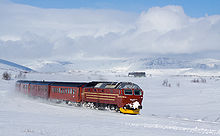 Di 4 on the Nordland Line
Di 4 on the Nordland Line
Intercity trains / Long-distance trains
The intercity trains (fjerntog) services are offered on the Bergen Line, the Dovre Line and the Sørland Line. The four day trains are operated with Class 73 electric multiple units (formerly branded as Signatur) or with traditional locomotive pulled trains (electric locomotives El18 and coaches Class 7). A night train service with WLAB2 sleeping coaches is also offered on these lines. On the Nordland Line between Trondheim and Bodø NSB operates using diesel locomotives Di4, making it the only line still serviced by such for regular passenger service.
These routes are operated:
- Oslo–Trondheim (Dovrebanen) (via: Lillestrøm, Oslo Airport Gardermoen, Hamar, Brumunddal, Moelv, Lillehammer, Hunderfossen, Ringebu, Vinstra, Kvam, Otta, Dovre, Dombås, Hjerkinn, Kongsvoll, Oppdal, Berkåk, Støren, Heimdal, Trondheim S)
- Oslo–Bergen
- Oslo–Kristiansand
Regional trains
NSB has two regional rail services. All regional trains are to receive the new livery of red and grey. NSB has previously used the brand name Agenda on its regional services.
Regional services use Class 70 (Skien–Lillehammer) and Class 73b (Oslo S – Halden – (Gothenburg)). The service is provided hourly along the Trunk Line, the Vestfold Line and the Østfold Line. The trains running between Lillehammer and Skien serve Oslo Airport, Gardermoen, providing an alternative to the Oslo Airport Express Train (Flytoget).
On the non-electrified Meråker Line, Nordland Line, Rauma Line and Røros Line. NSB operates regional services using NSB Class 92 and Class 93 diesel multiple units. NSB operates the following routes:
- Trondheim–Bodø (Nordland Line)
- Trondheim–Östersund (Sweden) (Meråker Line)
- Trondheim–Røros (Røros Line)
- Trondheim–Oppdal (Dovre Line)
- Røros–Hamar (Røros Line)
- Dombås–Åndalsnes (Rauma Line)
Commuter trains
Around the cities of Arendal, Bergen, Oslo, Skien, Stavanger and Trondheim NSB operates commuter train services using Class 69 and Class 72 electric multiple units and Class 92 diesel multiple units. The services usually have hourly or semi-hourly frequency. NSB tried using the brand name Puls for the commuter trains, and have painted some of the trains green. The Puls brand has been discontinued.
Around Oslo the following services are provided: (with Class 69 and Class 72)
- (Drammen)–Asker–Oslo–Lillestrøm (Trunk Line and Drammen Line)
- Drammen–Skøyen–Oslo–Jessheim–Dal (Trunk Line and Drammen Line)
- Eidsvoll–Oslo–Drammen–Kongsberg (Trunk Line and Sørland Line)
- Skøyen–Lillestrøm–Årnes–(Kongsvinger) (Kongsvinger Line)
- Skøyen–Oslo–Ski (Østfold Line)
- Spikkestad–Oslo–Moss (Spikkestad Line and Østfold Line)
- Skøyen–Oslo–Mysen–(Rakkestad) (Østfold Line)
Other commuter train services:
- Stavanger–Egersund (Sørland Line) with Class 72
- Bergen–Voss–Myrdal (Bergen Line) with Class 69
- Lerkendal–Trondheim–Steinkjer (Nordland Line) with diesel Class 92, on what used to be called Trønderbanen
- Porsgrunn–Notodden (Bratsberg Line) with Y1 class railcar
- Arendal–Nelaug (Arendal Line) with Class 69
Gjøvikbanen
Main article: NSB GjøvikbanenServices on Gjøvik Line were in 2005 transferred to NSB Gjøvikbanen after the NSB subsidiary had won a public tender bid for a ten-year public service obligation contract with the Norwegian Ministry of Transportation and Communication. The Norwegian Minister of Transportation and Communications, Liv Signe Navarsete (Centre Party), has announced that the present government (as of 2006) will discontinue the previous governments announcements to put more rail line operations on public tender.
Rolling stock
Main article: Norges Statsbaner rolling stockDuring the 1990s NSB modernised their rolling stock, expanding their fleet of multiple units and retiring many of the traditional locomotive-hauled trains. Most of the locomotives were sold to the freight company CargoNet AS, but the models El18 and Di4 remain to pull passenger trains. Some of the new trains were plagued with troubles, in particular a brand new Class 73 derailed (fortunately at low speed) at Nelaug in 2000 because of an axle breaking due to metal fatigue. As of 2005 however, these trains have been performing satisfactorily.
In August 2008, NSB announced it had ordered 50 new five-unit trainsets of the Stadler FLIRT class.[3] These will be used for local service in the Greater Oslo area (24 sets) and also regional service in southern Norway (26 sets). The delivery is scheduled for 2012, by that time much of the rail network is expected to be upgraded to double track, enabling an increase in frequency.[4] The contract which is worth approximately 840 mill. Swiss francs gives NSB an option to buy an additional 100 sets.[5] These trainsets have been specifically modified to operate in Norwegian climate and have a maximum speed of 200 km/h.
Locomotives
- 2 Di 2 class diesel shunters
- 5 Di 4 class diesel locomotives, used mostly on Nordlandsbanen.
- 9 El 17 class electric locomotives, three used for shunting and six run on Flåmsbana.
- 22 El 18 class electric locomotives, used on all main electrified lines.
Electric multiple units
- 80 Class 69 class 2-car or 3-car commuter trains, used around Oslo, Bergen and Arendal.
- 16 Class 70 class 4-car intercity (medium distance) trains, used around Oslo.
- 36 Class 72 class 4-car commuter trains, used around Oslo and Stavanger.
- 16 Class 73 class 4-car long-distance trains, used on Bergensbanen, Dovrebanen and Sørlandsbanen.
- 6 Class 73b class 4-car intercity version of the Class 73 used on Østfoldbanen.
Diesel multiple units
- 14 Class 92 class 2-car trains used for commuter services around Trondheim, and on Rørosbanen.
- 15 Class 93 class 2-car trains used on long distance and intercity services on Rørosbanen, Nordlandsbanen and Raumabanen. Also known as Bombardier Transportation Talent BR643 Diesel Multiple Unit.
Diesel railcar
Carriages
Main article: Norwegian railway carriages- The non-motorized passenger carriages in operation are the B3-series (the oldest), B5-series and B7-series. The B7-series remain in service on long distance express trains while the others are usually on medium-haul duty.
Subsidiaries
- Complete ownership of Arrive AS (IT services)
- Complete ownership of Mantena AS (Rolling stock maintenance)
- Complete ownership of Nettbuss AS (Bus operations)
- Complete ownership of NSB Anbud AS (Operates train services on Gjøvikbanen)
- Complete ownership of ROM Eiendom AS (Real estate development)
- Complete ownership of Tågkompaniet (Sweden)
- 55% of CargoNet AS, the other 45% is owned by Swedish owned Green Cargo (Freight train operation)
- 55% of Trafikkservice, the other 45% owned by Integrated Service Solutions (Cleaning services)
Chief executives
-
This list is incomplete; you can help by expanding it.
The title was changed from director-general to chief executive officer in the late 1980s.
- 1883–1899: Lorentz Henrik Müller Segelcke
- 1910–1912: August Fleischer (acting)
- 1912–1919: Christian Emil Stoud Platou (acting)
- 1919–1922: Theodor Holtfodt
- 1924–1938: Eivind Heiberg
- 1939–????: Waldemar Hoff
- 1944–????: Bjarne Vik (Nazi Collaborator)
- 1945–1946: Løken (acting)
- 1946–1950: Egil Sundt (acting)
- 1950–1951: Olav Holtmon (acting)
- 1951–1966: Halvdan Eyvind Stokke
- 1967–1978: Edvard Heiberg
- 1978–1988: Robert Nordén
- 1987–1988: Tore Lindholt (acting)
- 1988–1990: Kjeld Rimberg
- 1990–1990: Tore Lindholt (acting)
- 1990–1995: Kristian Rambjør
- 1995–2000: Osmund Ueland
- 2000–2000: Randi Flesland (acting)
- 2000–2001: Arne Wam (acting)
- 2001–2011: Einar Enger
- 2011–: Geir Isaksen
See also
References
- ^ Pryser, Tore Norsk Historie 1814–1860, volume four of Norsk historie, Det Norske Samlaget, Oslo, 1999 ISBN 82-521-5184-1 (Norwegian)
- ^ http://www.flytoget.no/Templates/Informasjon.aspx?id=116 (Norwegian) Flytoget: About
- ^ Berglund, Nina. "NSB invests in new trains". Aftenposten. http://www.aftenposten.no/english/local/article2602721.ece. Retrieved 2008-08-21.
- ^ Milliard-Flirt for NSB (dn.no) , August 19, 2008; accessed August 20, 2008(Norwegian)
- ^ Solholm, Rolleiv. "New trains for Norwegian Railways". The Norway Post. http://www.norwaypost.no/cgi-bin/norwaypost/imaker?id=184627. Retrieved 2008-08-21.[dead link]
Further reading
- Jernbaneverket Historie (Norwegian)
- Norsk Jernbanemuseum Historie (Norwegian)
- Part V. The Brofos Catalog of the Railway Stamps of Norway (English)
External links
Railway companies of Norway Current Airport Express Train · Cargolink · CargoNet · Malmtrafikk · Norwegian State Railways · NSB GjøvikbanenFormer Dunderland · Elkem · Grimstad · Lier · Lillesand–Flaksvand · Linx · Nesttun–Os · Norsk Transport · Norwegian State Railways · Ofotbanen · Oslo Lysverker · Salvesen & Thams · Sydvaranger · Trunk · Urskog–Høland · Valdres · Vestfolds PrivatbanerGovernment enterprises of Norway Argentum • BaneService • Electronic Chart Centre • Entra Eiendom • Flytoget • Gassco • Kings Bay • Mesta • Norsk Rikskringkasting • Norsk Tipping • Norwegian State Railways • Petoro • Posten • Secora • SIVA • Statkraft • Statnett • Store Norske • Uninett • VinmonopoletSee also: Category:Government-owned companies in Norway • List of Norwegian government enterprisesNorwegian Ministry of Transport and Communications Companies Infrastructure Authorities National railway companies of Europe  HSH •
HSH •  HYU1 •
HYU1 •  ÖBB •
ÖBB •  ADY1 •
ADY1 •  BŽD/BČ •
BŽD/BČ •  SNCB/NMBS •
SNCB/NMBS •  ŽFBH2 and ŽRS3 •
ŽFBH2 and ŽRS3 •  BDŽ •
BDŽ •  HŽ •
HŽ •  ČD •
ČD •  DSB •
DSB •
 EVR •
EVR •  VR •
VR •  SNCF •
SNCF •  SR1 •
SR1 •  DB •
DB •  TrainOSE •
TrainOSE •  MÁV •
MÁV •  IÉ •
IÉ •  FS •
FS •  KTŽ1 •
KTŽ1 •  HK/KŽ4 •
HK/KŽ4 •  LDZ •
LDZ •  LG •
LG •
 CFL •
CFL •  MŽ •
MŽ •  CFM •
CFM •  ŽCG •
ŽCG •  NS •
NS •  NSB •
NSB •  PKP •
PKP •  CP •
CP •  CFR •
CFR •  RŽD •
RŽD •  ŽS •
ŽS •  ŽSR •
ŽSR •  SŽ •
SŽ •
 RENFE •
RENFE •  SJAB •
SJAB •  SBB/CFF/FFS •
SBB/CFF/FFS •  TCDD1 •
TCDD1 •  UZ •
UZ •  BR5 / NR6 / NIR71Country partly in Asia • 2For the Federation BH • 3For Srpska • 4State with limited recognition • 51948-2000
BR5 / NR6 / NIR71Country partly in Asia • 2For the Federation BH • 3For Srpska • 4State with limited recognition • 51948-2000
6Created in 1999, owned by ATOC • 7For Northern IrelandCategories:- Railway companies established in 1996
- 1996 establishments in Norway
- Railway companies of Norway
- Rail transport in Norway
- Government-owned companies in Norway
- Norwegian State Railways
Wikimedia Foundation. 2010.

